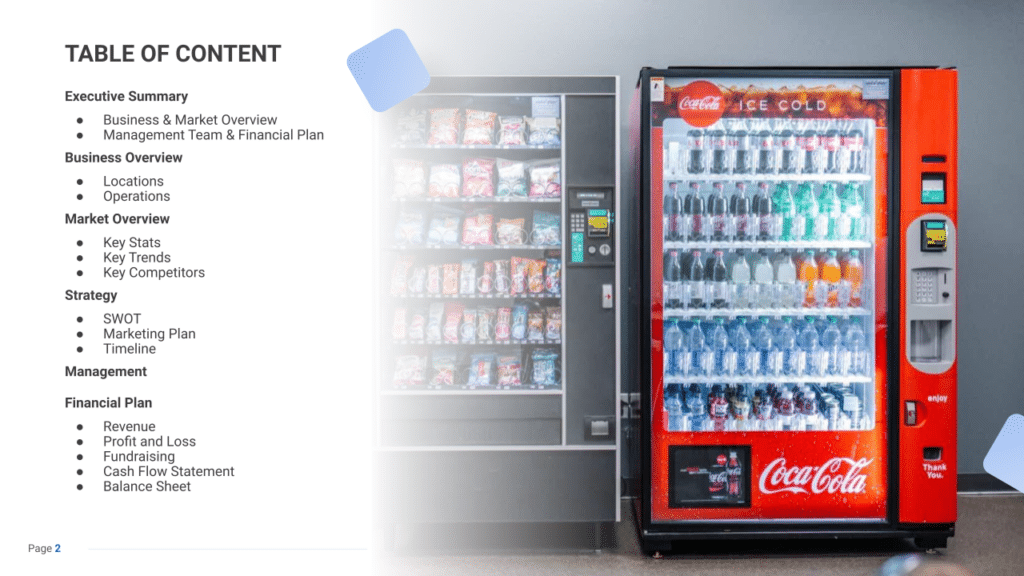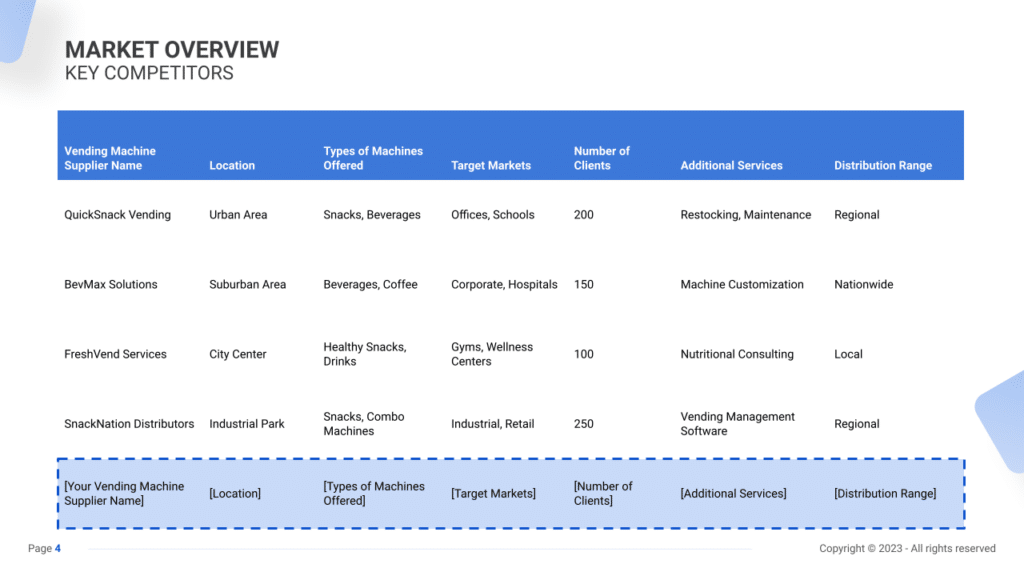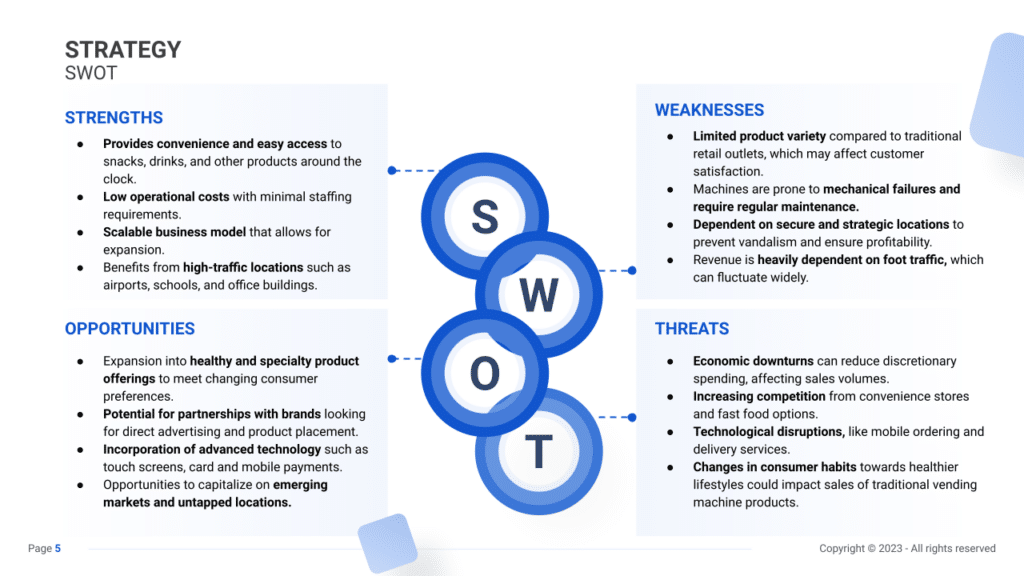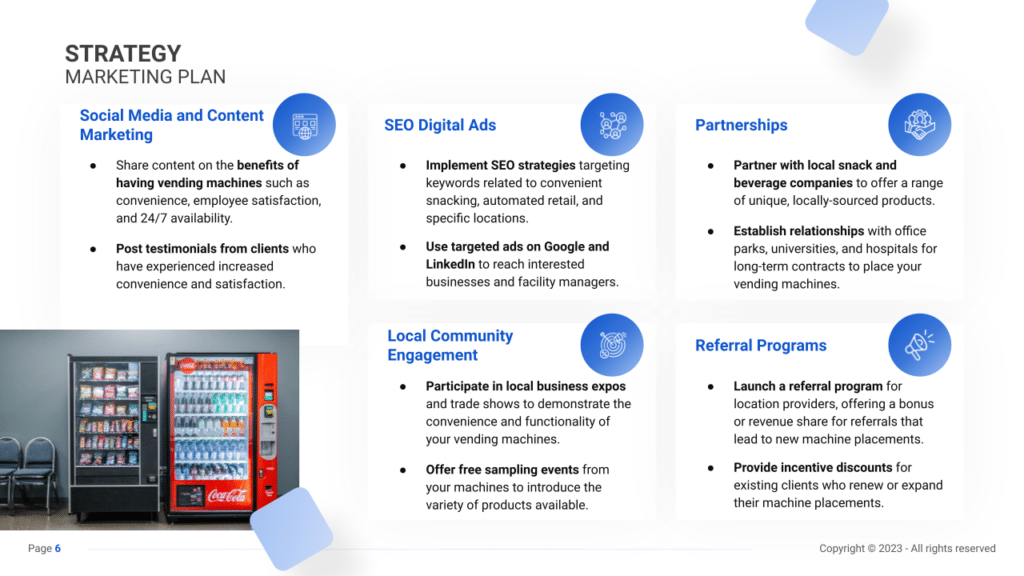Vending Machine Business Plan Template & PDF Example

Creating a comprehensive business plan is crucial for launching and running a successful vending machine business. This plan serves as your roadmap, detailing your vision, operational strategies, and financial plan. It helps establish your vending machine business’s identity, navigate the competitive market, and secure funding for growth.
This article not only breaks down the critical components of a vending machine business plan, but also provides an example of a business plan to help you craft your own.
Whether you’re an experienced entrepreneur or new to the retail industry, this guide, complete with a business plan example, lays the groundwork for turning your vending machine business concept into reality. Let’s dive in!
The Plan
Our vending machine business plan is structured to cover all essential aspects needed for a comprehensive strategy. It outlines the business’s operations, marketing strategy, market environment, competitors, management team, and financial forecasts.
- Executive Summary: Offers an overview of your vending machine business’s concept, market analysis, management, and financial strategy.
- Business Overview: Provides detailed information on what your vending machine business offers and its operational model:
- Locations: Describes the locations of your vending machines and why these locations are appealing to potential clients.
- Operations: Describes the operational aspects of your business, including maintenance schedules, supply chain management, and customer service protocols.
- Market Overview: Examines the vending machine industry landscape, identifying competitors and how your business stands out:
- Key Stats: Shares industry size, growth trends, and relevant statistics for the vending machine market.
- Key Trends: Highlights recent trends affecting the vending machine sector.
- Key Competitors: Analyzes main competitors nearby and how your business differs from them.
- Strategy: Outlines how the vending machine business intends to achieve growth and attract clients:
- SWOT: Strengths, weaknesses, opportunities, and threats analysis.
- Marketing Plan: Strategies for attracting and retaining customers.
- Timeline: Key milestones and objectives from start-up through the first year of operation.
- Management: Information on who manages the vending machine business and their roles.
- Financial Plan: Projects the business’s 5-year financial performance, including revenue, profits, and expected expenses.

Executive Summary
The Executive Summary introduces your vending machine business plan, offering a concise overview of your business and its services. It should detail your market positioning, the variety of products offered through the vending machines, their locations, and an outline of day-to-day operations.
This section should also explore how your vending machine business will integrate into the local market, including the number of direct competitors within the area, identifying who they are, along with your business’s unique selling points that differentiate it from these competitors.
Furthermore, you should include information about the management and co-founding team, detailing their roles and contributions to the business’s success. Additionally, a summary of your financial projections, including revenue and profits over the next five years, should be presented here to provide a clear picture of your business’s financial plan.
Vending Machine Business Plan Executive Summary Example
Business Overview
For a vending machine business, the Business Overview section can be concisely divided into 2 main slides:
Locations
Briefly describe the vending machines’ physical setup, emphasizing their modern design, ease of use, and the convenience they offer to customers. Mention the specific locations of the vending machines, highlighting their accessibility and strategic placement in high-traffic areas such as shopping centers, office buildings, schools, or public transportation hubs. Explain why these locations are advantageous in attracting your target clientele.
Operations
Detail the operational aspects of the vending machine business, including inventory management, restocking schedules, and maintenance routines. Explain how you will ensure machines are always stocked with fresh products and are functioning properly. Highlight any technology used for inventory tracking, payment processing, and remote monitoring to enhance efficiency. Additionally, outline your customer service approach, ensuring customers have a seamless experience and can easily report any issues or provide feedback.
Market Overview

Industry Size & Growth
Examine the size of the vending machine industry and its growth potential. Discuss the current market size, revenue generation, and projected growth rates to understand the market’s scope and expansion opportunities.
Key Market Trends
Highlight recent market trends, such as the demand for convenient, 24/7 access to products, healthier snack options, and the use of technology in vending machines (e.g., cashless payments, touchless interfaces). Note the rising interest in eco-friendly products and specialized vending machines catering to specific needs.
Competitive Landscape
A competitive analysis is not just a tool for gauging the position of your vending machine business in the market and its key competitors; it’s also a fundamental component of your business plan.
This analysis helps in identifying your vending machine business’s unique selling points, essential for differentiating your business in a competitive market.
In addition, the competitive analysis is integral in laying a solid foundation for your business plan. By examining various operational aspects of your competitors, you gain valuable information that ensures your business plan is robust, informed, and tailored to succeed in the current market environment.
Identifying Your Competitors in the Vending Machine Industry
The initial step in a competitive analysis is to identify your competitors. Start by listing other vending machine operators in the area. If your focus is on healthy snack options, your direct competitors include other vending machines offering similar products as well as larger food service providers that may have vending machines in strategic locations. Additionally, consider indirect competitors like convenience stores or small eateries offering quick snack options.
Use online tools such as Google Maps for a geographical overview of where competitors are located. Platforms like Yelp and other customer review sites can provide insights into the strengths and weaknesses of these competitors through consumer reviews. For example, if a competitor is frequently praised for the variety and freshness of its offerings in a high-traffic location, these are significant strengths.

Vending Machine Competitors’ Strategies
Analyzing the strategies of these competitors involves various aspects:
- Product Offerings: Evaluate the diversity of products in their machines. If a nearby operator, “Healthy Snack Hub,” is popular for its organic and vegan snacks, this indicates a consumer trend towards healthier eating.
- Technological Integration: Assess the technology used in vending machines. Companies like “TechVend” that incorporate touch screens and cashless payment options might appeal more to tech-savvy consumers.
- Pricing Strategy: Compare your prices with those of competitors. Are your products priced similarly to those in “EconoVend” machines, or are they aligned with more premium options like those found in “LuxSnacks”?
- Marketing Tactics: Look at how competitors promote their vending machines. Do they use online advertising, collaborate with venue owners, or rely on strategic placement in high-footfall areas?
- Customer Experience: Evaluate the convenience and user experience offered by competitors’ machines. For example, “QuickSnack Vends” might be known for its easy-to-use interface and fast transaction times, enhancing customer satisfaction.
- Operational Efficiency: Note if competitors use innovative processes or technologies to streamline restocking and maintenance, like “VendTech Solutions” with its remote monitoring systems.
What’s Your Vending Machine Business’s Value Proposition?
Consider what makes your vending machine business unique. Maybe you provide an exclusive selection of imported chocolates, or perhaps your machines are located in underserved rural areas.
Explore market gaps through customer feedback and industry trends. For instance, a growing interest in cashless and contactless payment options could be a market opportunity if not widely offered by competitors.
Think about your locations: Vending machines in high-traffic areas like airports and shopping malls might focus on quick snacks and drinks, while those in office buildings could offer more substantial meal options or specialty beverages.
Strategy

SWOT
First, conduct a SWOT analysis for the vending machine business, highlighting Strengths (such as strategic locations and 24/7 accessibility), Weaknesses (including high initial setup costs and maintenance requirements), Opportunities (for example, increasing demand for healthy and organic products), and Threats (such as economic downturns that may decrease consumer spending on non-essential items).

Marketing Plan
Next, develop a marketing strategy that outlines how to attract and retain customers through targeted advertising, promotional discounts, an engaging social media presence, and community involvement.
Marketing Channels
Utilize diverse marketing channels to reach potential customers and promote your vending services effectively.
Digital Marketing
Leverage digital platforms:
- Social Media: Utilize platforms like LinkedIn for business connections and Instagram for engaging content showcasing your vending products and locations. Engage with your audience through comments and direct messages.
- Email Marketing: Build an email subscriber list by offering incentives. Send regular newsletters featuring vending updates, promotions, or new product launches.
- Website and SEO: Develop a user-friendly website showcasing your vending offerings, locations, and blog content related to snacks, health tips, or sustainability. Optimize for local SEO to enhance visibility in relevant search results.
Local Advertising
Connect with communities:
- Location-based Ads: Advertise in local directories, community newsletters, or sponsor events to increase visibility in specific regions.
- Partnerships: Collaborate with businesses (gyms, schools, offices) to place machines in high-traffic areas. Offer revenue-sharing models or exclusive deals to incentivize partnerships.
Promotional Activities
Attract attention through promotions:
- Discounts and Bundles: Introduce promotions like ‘Healthy Snack Week’ or ‘Buy One, Get One Free’ offers to drive sales.
- Loyalty Programs: Implement loyalty cards or digital rewards for frequent customers, offering discounts or free products after a certain number of purchases.
- Referral Programs: Incentivize referrals by providing discounts to existing customers who refer new locations or customers.

Sales Channels
Optimize sales strategies for vending success:
- Strategic Machine Placement: Identify prime locations frequented by your target audience—places like corporate offices, gyms, schools, or transportation hubs. Negotiate placements with property owners or managers. Continuously monitor machine performance data to assess and adapt placements for optimal sales.
- Interactive Vending Features: Enhance customer engagement by implementing interactive screens or personalized experiences in vending machines. Offer customization options, product information, or entertaining features to attract and engage customers.
- Data-Driven Decision-Making: Utilize sales data and machine analytics to make informed decisions. Understand which products are popular, peak purchasing times, and optimize inventory management. This data-driven approach ensures efficient stock replenishment and better customer satisfaction.
Customer Retention and Upselling
Focus on retaining customers and maximizing sales.
- Customer Engagement: Collect customer feedback through surveys, QR codes, or feedback forms placed near vending machines. Offer incentives, such as discounts or free samples, to encourage participation. Utilize the gathered insights to enhance product offerings or vending experiences.
- Upselling and cross-selling: Implement suggestive selling techniques through screen prompts or labels. Encourage customers to try complementary products or opt for larger sizes, increasing the average transaction value.
Innovative Strategies
Stay ahead with innovation and modern solutions.
- Cashless Payment Integration: Incorporate contactless payment options like credit/debit cards, mobile wallets, or NFC technology. Offer convenience and hygiene while catering to the growing preference for cashless transactions.
- Healthy and Sustainable Options: Emphasize healthier snack choices and sustainable practices. Showcase healthier alternatives prominently and highlight eco-friendly practices like recyclable packaging or energy-efficient machines. Appeal to conscientious consumers who prioritize health and sustainability.
Strategy Timeline
Finally, create a detailed timeline that outlines critical milestones for the vending machine business’s setup, marketing efforts, customer base growth, and expansion objectives, ensuring the business moves forward with clear direction and purpose.

Management
The Management section focuses on the vending machine business’s management and their direct roles in daily operations and strategic direction. This part is crucial for understanding who is responsible for making key decisions and driving the vending machine business toward its financial and operational goals.
For your vending machine business plan, list the core team members, their specific responsibilities, and how their expertise supports the business.


Financial Plan
The Financial Plan section is a comprehensive analysis of your financial projections for revenue, expenses, and profitability. It lays out your vending machine business’s approach to securing funding, managing cash flow, and achieving breakeven.
This section typically includes detailed forecasts for the first 5 years of operation, highlighting expected revenue, operating costs and capital expenditures.
For your vending machine business plan, provide a snapshot of your financial statement (profit and loss, balance sheet, cash flow statement), as well as your key assumptions (e.g. number of customers and prices, expenses, etc.).
Make sure to cover here
_ Profit and Loss
_ Cash Flow Statement
_ Balance Sheet
_ Use of Funds









